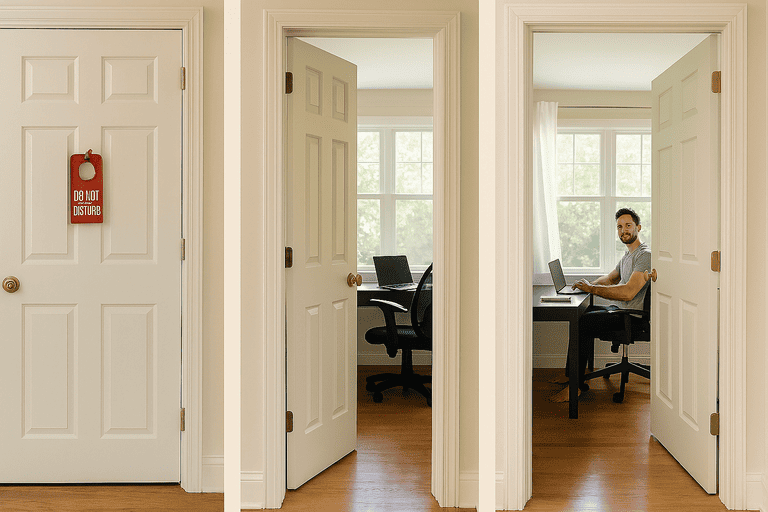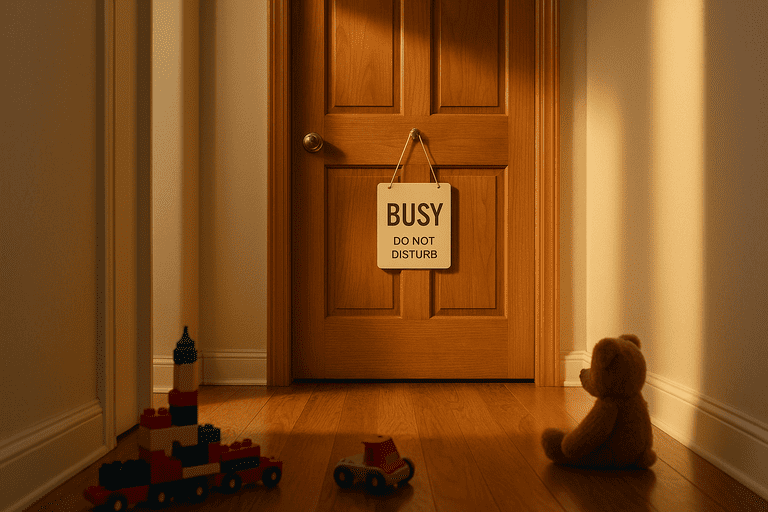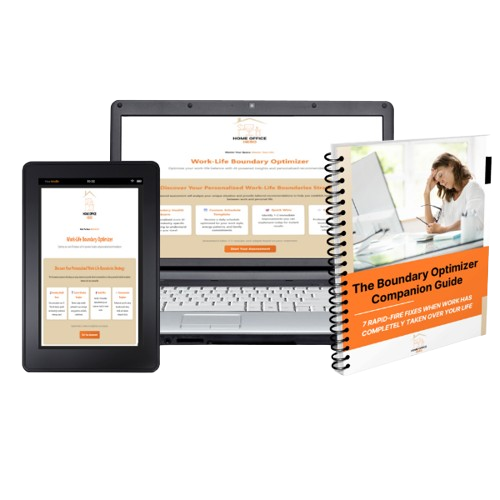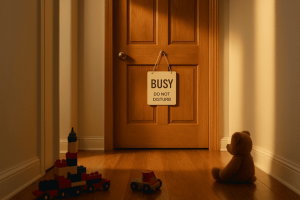Last summer, during school holidays, I sat Shaw down for what I thought would be a simple conversation.
“Buddy, I need you to understand something. When I’m in my office with the door closed, it means I’m working. I can’t be interrupted unless it’s an emergency.”
He nodded. He’s a smart kid. I thought we were sorted.
Twenty minutes into my first client call, there he was. Pushing open my office door. “Dad, I can’t login to my Roblox account on my PC. Can you help?”
That moment—trying to mute myself while apologising to my client, seeing Shaw’s confused face when I firmly said “not now,” then dealing with the guilt that followed—crystallised everything wrong with how I’d been approaching work from home boundaries with kids .
This post will show you how to set clear, enforceable boundaries that actually work for remote working parents. Not through willpower or hoping your family “gets it,” but through simple systems that remove the guesswork for everyone involved. This is part of our complete guide on Work-Life Balance for Remote Working Parents .
You’ll learn the exact communication scripts, visual signaling systems, and flexibility frameworks that transformed my chaotic home office into a space where both focused work and guilt-free family time coexist.
The Real Problem With Work From Home Boundaries
Here’s what nobody tells you: your family doesn’t interrupt you to be difficult. They interrupt because you haven’t made your availability obvious enough for them to understand.
After 6 years building my agency from home with a young son, I’ve learned that work from home boundaries aren’t about being stricter or training your family to respect your time. They’re about creating systems so clear that a 10-year-old can navigate them without confusion.
The traditional advice—”just tell your kids you’re working”—assumes your family can read your mind. They can’t see the difference between you checking emails casually and you being in a critical client presentation. To them, you’re just on your laptop. Again.
This ambiguity creates a terrible cycle. Your son interrupts. You get frustrated. He feels rejected. You feel guilty. Nobody wins. The boundary fails because it was never clear enough to succeed.
The turning point came when I realised I was asking Shaw to make judgment calls about when I was “really” working versus just “on the computer.” That’s an impossible standard for a child. Hell, it’s an impossible standard for most adults.
Work from home boundaries with kids require crystal-clear external signals that remove all guesswork. Not expectations. Not hoping they’ll figure it out. Actual visible systems that communicate your status without anyone needing to ask.

The Four Types of Boundaries Every Remote Working Parent Needs
Physical Boundaries: Making Your Workspace Obvious
Your first boundary is spatial. It tells your family: “This is my work zone.”
I learned this the hard way when I was working from the kitchen table. Shaw couldn’t differentiate between “Dad’s working” and “Dad’s just sitting there.” When I moved to a dedicated space—even just a corner with a screen divider—everything shifted.
The implementation: Designate a specific physical area as your workspace. If you don’t have a separate room, use visual markers: a folding screen, a specific chair that’s only for work, a desk lamp that’s only on during work hours.
The rule is simple: when you’re in your workspace, you’re working. When you’re not, you’re available. No gray area.
Time Boundaries: Your Non-Negotiable Focus Blocks
This is where I failed repeatedly before creating a system. I’d tell Shaw “I’m working until lunch” but then pop out to grab coffee, check on him, or “quickly” answer a question. I was training him that my time boundaries were negotiable.
The framework that works: Time-block your day and communicate specific end times, not durations.
Instead of “I need to work for two hours,” try “I’m working until 11:30am, then I’m all yours for lunch.” Kids (and partners) can grasp specific clock times much better than abstract durations.
During school holidays, I started showing Shaw my time blocks on a simple visual schedule. “Dad’s working: 9-11:30am. Dad time: 11:30am-1pm. Dad’s working: 1-3pm. Family time: 3pm onwards.”
The game-changer was this promise: “If you let me work undisturbed during my focus blocks, I guarantee you’ll have my complete attention during our time together. No laptop. No phone. Just us.”
Communication Boundaries: The Scripts That Actually Work
After months of trial and error, here are the exact phrases I use:
Setting expectations (morning conversation with Shaw): “I’ve got three important work blocks today. During those times, my door will be closed with the ‘Do Not Disturb’ sign up. That means I can’t be interrupted unless someone’s hurt or the house is on fire. When you see my door partially open with no sign, I’m available for quick things. When it’s wide open, come find me anytime. Can you explain back to me what a closed door with the sign means?”
When boundaries are tested: “I can see you need me, and I want to help. I’ve got 15 minutes left in this work block, then I’m completely yours. Can it wait, or is this an emergency?”
Acknowledging their struggle: “I know it’s hard waiting when you want to show me something exciting. That’s why I promise that when my work block ends, you get my full attention. No distractions.”
The secret is making the boundary about protecting your time for them, not from them.
Visual Boundaries: Door Signals and Status Indicators
This system changed everything. The door itself became my communication tool—combined with a simple sign for absolute clarity.

The door system I use:
- Door closed + “Do Not Disturb” sign: Deep focus work, client calls, important deadlines. Interruptions only for genuine emergencies.
- Door partially open (no sign): Available for quick questions or brief check-ins about genuinely important things.
- Door wide open (no sign): Work session ending or completely available. Come on in.
Shaw learned this system in about a week. The key was consistency—I had to honor what each door position meant, every single time.
The beauty of this system is it works even when you’re on a call and can’t verbally communicate your status.
Making Boundaries Work: The Communication Script for Families
The biggest mistake I made was assuming my family would naturally understand my boundaries once I explained them. They didn’t. Not because they didn’t care, but because I never properly onboarded them into the system.
The family meeting script I wish I’d used years earlier:
“I want to talk about something important. I’ve been frustrated lately when I get interrupted during work, and I know you’ve been confused about when you can talk to me. That’s not fair to any of us. So I’m setting up a clear system that removes the guesswork.
Here’s how it works: [Explain your door positions and sign]
I promise you three things:
- When my door is closed with the sign up during a work block, I’ll take it down and open the door exactly when I say I will.
- When my door opens, you get my complete attention—no phone, no laptop, just us.
- If something’s genuinely important or if you’re hurt, you can always interrupt. Always.
The trade-off is this: during work blocks when my door is closed with the sign, I need no interruptions for non-emergencies. In return, you get the fully present version of me during our time together.
Can everyone agree to try this for one week?”
For younger kids, simplify to: “Closed door with sign means wait. Door open a little bit means you can ask me quick things. Wide open door means come play with me.”
This isn’t about controlling your family. It’s about creating predictability that reduces everyone’s stress. When boundaries are clear, there’s no confusion, no rejection, no guilt.
When to Be Flexible (Because Life Happens)
Here’s what experience has taught me: rigid boundaries in a family home will eventually break. The question isn’t if they’ll be tested—it’s how you handle it when they are.
The flexibility framework:
True emergencies override everything. When Shaw fell and needed stitches, the client call ended immediately. No guilt, no hesitation. Your family always comes first in real crises.
Occasional special moments warrant bending rules. When Shaw scored his first try in rugby and burst into my office to tell me mid-workday, I took three minutes to celebrate with him. That memory matters more than protecting those three minutes.
Regular violations signal a system problem, not a discipline problem. If your boundaries are constantly broken, your system isn’t clear enough or your time blocks don’t match your family’s needs. Adjust the system, not your expectations of your family.
Build in buffer time. I learned to add 15 minutes of flex time between work blocks and family commitments. This cushion means unexpected interruptions don’t create domino-effect stress.
The goal isn’t perfection. It’s creating a structure clear enough that when you do need to be flexible, it’s a conscious choice rather than constant chaos.
As someone who struggled with this for years, I can tell you: remote work boundaries aren’t about being rigid or distant from your family. They’re about creating enough structure that everyone knows what to expect. That predictability reduces stress for everyone and creates space for both focused work and guilt-free presence.
Implementation: Your Next Steps
Start simple. Don’t try to implement all four boundary types at once. Here’s what to do today:
Step 1 (5 minutes): Decide on your door positions and get a simple “Do Not Disturb” sign. Closed door + sign = deep focus, partially open = available for quick things, wide open = fully available.
Step 2 (10 minutes): Have a brief family meeting. Explain the signal and what it means. Get their agreement to try it for three days.
Step 3 (Today): Use your signal during your next focused work block. When it’s over, immediately go to your family and give them your full attention.
Common mistakes to avoid:
- Being inconsistent with door positions and sign usage (letting “just one” interruption slide when door is closed with sign)
- Forgetting to remove the sign or open your door when you’re actually available
- Not following through on your promise to be present after work blocks
- Punishing family members when they’re still learning the system
The first week will be bumpy. Shaw tested my boundaries multiple times. But by week two, something remarkable happened: he started respecting my closed door with the sign because he knew family time was protected and predictable.
Your boundaries will look different than mine. You might have toddlers who can’t read a clock, a partner who works shifts, or clients across multiple time zones. Adapt the principles to your situation. The core truth remains: clear systems beat willpower every single time.
Conclusion
Setting work from home boundaries with kids isn’t about being stricter or expecting your family to read your mind. It’s about creating systems so clear that everyone knows exactly when you’re available and when you’re not.
The essentials:
- Physical boundaries define your workspace
- Time boundaries create predictable focus blocks
- Communication boundaries set clear expectations
- Visual boundaries remove all guesswork
The real win isn’t just better work focus. It’s the guilt-free family time that comes after. When Shaw and I hang out now, I’m completely present because I know my work got done during protected time. That presence is worth every closed door and sign I’ve put up.
For more on managing the emotional side of this journey, read our guide on Work From Home Parent Guilt: Why It Happens and How to Release It
One question for you: What’s the biggest challenge you face when trying to set boundaries at home? Drop a comment below—I read and respond to every one.
Continue Reading
For the complete guide on achieving work-life harmony as a remote working parent, see Work-Life Balance for Remote Working Parents: The Complete 2025 Guide
Related articles you’ll find helpful:
- Work-Life Boundaries Remote Working Parents Need (And How to Set Them)
- Work From Home Parent Guilt: Why It Happens and How to Release It
Footer Note
Part of the Work-Life Balance & Harmony series. For the complete guide, see our Work-Life Balance for Remote Working Parents pillar post










